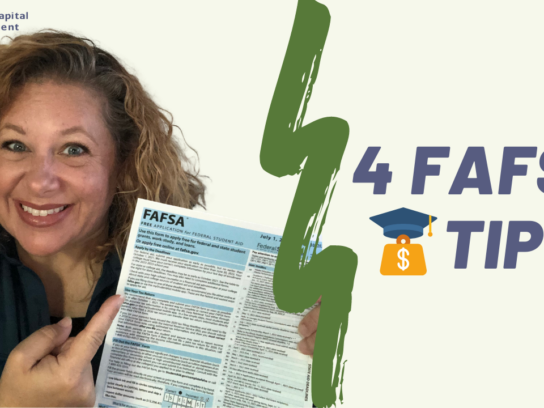
Every person who is about to attend college should know about the Free Application for Federal Student Aid and the process to apply. October means that the FAFSA applications are open for 2022-2023. Our video blog is going to cover commonly asked questions and 4 FAFSA tips.
What is FAFSA and how does it work?
The Free Application for Federal Student Aid (FAFSA) is the official form that all incoming and returning college students fill out for the next academic year. The FAFSA is a prerequisite for federal student loans, grants, and work-study, and may be required by colleges before they distribute their institutional aid to students.
In order to determine the financial need of a family, the FAFSA asks a number of questions about a family’s income, the student’s income, assets, and other factors such as how many children are in the family. It then comes up with an Expected Family Contribution (EFC). In July 2023, EFC will be renamed the Student Aid Index (SAI) to clarify its meaning. Based on the information you supply on the FAFSA will determine if you qualify for need-based aid, non-need-based aid, or some combination of the two.
How much will FAFSA give me?
The amount of money that you receive is dependent on what they determine to be your financial need. The average amount is around $5,000.
Tip #1: How do I get started with the FAFSA Application?
First, you and your student will each need to obtain a Federal Student ID, FSA ID, (which you can do online by following the instructions at studentaid.gov. Once you have an FSA ID, you can use the same one each year.
Secondly, you will need to submit the FAFSA. The fastest and easiest way to submit it is online at studentaid.gov. The online FAFSA allows your tax data to be directly imported from the IRS, which speeds up the overall process and reduces errors. The site contains resources and tools to help you complete the form, including a list of the documents and information you’ll need to file it. Students must submit the FAFSA every year to be eligible for financial aid (along with any other college-specific financial aid form that may be required, such as the CSS Profile). Any colleges you list on the FAFSA will also get a copy of the report. There is no cost to submit the application. It will take about 45-60 minutes to complete and it’s best if you complete it with your student.
Tip #2: How does the FAFSA calculate financial need?
The FAFSA looks at a family’s income, assets, and household information (for example, family size) to calculate what a family can afford to pay. This figure is known as the EFC, or expected family contribution. All financial aid packages are built around this number.
When counting income, it uses information in your tax return from two years earlier. This year is often referred to as the “base year” or the “prior-prior year.” For example, the 2022-2023 FAFSA will use income information in your 2020 tax return, so 2020 would be the base year or prior-prior year.
When counting assets, it uses the current value of your and your child’s assets. Some assets are not counted and do not need to be listed on the FAFSA. These include home equity in a primary residence, retirement accounts (e.g., 401k, IRA), annuities, and cash-value life insurance. Student assets are weighted more heavily than parent assets; students must contribute 20% of their assets vs. 5.6% for parents.
Your EFC remains constant, no matter which college your student attends. The difference between your EFC and a college’s cost of attendance equals your student’s financial need. Your student’s financial needs will be different at every school because of the cost of attendance.
After your EFC is calculated, the financial aid administrator at your student’s school will attempt to craft an aid package to meet your child’s financial need by offering a combination of loans, grants, scholarships, and work-study. Keep in mind that colleges are not obligated to meet 100% of your child’s financial needs. If they don’t, you are responsible for paying the difference.
Tip #3: Should I file the FAFSA even if my student is unlikely to qualify for aid?
Yes, you should probably file a FAFSA even if your student is unlikely to qualify for aid. There are two good reasons to do this.
- All students attending college at least half-time are eligible for unsubsidized federal student loans, regardless of financial need or income level. (“Unsubsidized” means the borrower, rather than the federal government, pays the interest that accrues during school and during the grace period and any deferment periods after graduation.) If you want your child to be eligible for this federal loan, you’ll need to submit the FAFSA. But don’t worry, your child won’t be locked into taking out the loan. If you submit the FAFSA and then decide your child doesn’t need the student loan, your child can decline it through the college’s financial aid portal before the start of the school year.
- Colleges typically require the FAFSA when distributing their own need-based aid, and in some cases as a prerequisite for merit aid. So filing the FAFSA can give your child the broadest opportunity to be eligible for college-based aid. Similarly, many private scholarship sources may want to see the results of the FAFSA.
To find out our last tip and more about FAFSA, visit our FAFSA 2022-2023 blog here.


Comments are closed.